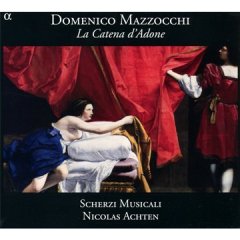Domenico Mazzocchi – La Catena d’Adone (Achten) [2012]
Domenico Mazzocchi – La Catena d’Adone (Achten) [2012]

Prologo 1-1 Sinfonia 16 2:14 1-2 De Puri Campi O Regnator Lucente (Apollo) 3:04 1-3 Le Saette Sov'i Rei (Ciclopi) - Ritornello 1:39 Atto 1 Scena I 1-4 E Qual Dolce Novella (Falsirena, Idonia) 8:27 Scena II 1-5 Rapido À Par De Venti (Adone, Echo) 4:13 1-6 Dunque Piagge Ridenti (Adone) 1:53 Scena III 1-7 Tanto Basti A L'incanto (Fasirena, Idonia, Adone) 6:15 1-8 Rida L'auretta Amante (Falsirena) 1:11 1-9 Mira, Mira Gioioso (Choro Di Ninfe E Di Pastori) 6:19 Atto 2 1-10 Sinfonia 12 1:56 Scena I 1-11 Dunque Oraspe Fedel Nuntio Ne Sei (Idonia, Oraspe, Arsete) 5:52 Scena II 1-12 O Nel Volto Non Meno (Falsirena, Oraspe, Idonia, Arsete) 9:07 1-13 Quà Trà Gioie Gradite (Falsirena) 0:58 Scena III 1-14 O Meravigile Altissime D?Amore (Choro Di Ninfe E Di Pastori) 4:38 Atto 3 2-1 Sinfonia 8 1:14 Scena I 2-2 Qual Indurato Scoglio (Arsete) 4:18 Scena II 2-3 Son Deste Le Mie Luci (Adone) 2:11 Scena III 2-4 Dove, Dove Ne Vai (Falsirena, Adone) 7:56 Scena IV 2-5 L'Alme Pure Degli Dei (Falsirena, Idonia, Oraspe, Chro Di Ninfe E Di Pastori) 8:48 2-6 Sù Sù Dunque Pastori (Choro Di Ninfe E Di Pastori) 1:30 Atto 4 2-7 Sinfonia 9 4:49 Scena I 2-8 O Con Dubbio Stupore (Idonia) 2:36 Scena II 2-9 Dubbiosa E Vacillante (Idonia) 1:47 Scena III 2-10 Per Cosi Lieve Brama (Falsirena, Plutone) 4:32 2-11 De la Maga Il Grave Accento (Choro Di Ninfe E Di Pastori) 3:15 Atto 5 2-12 Sinfonia 11 3:34 Scena I 2-13 Amor Non Sia Che Speri (Adone Solo) 3:11 Scena II 2-14 D'acque Magiche Sparsa (Falsirena, Adone) 4:34 2-15 Dunque Liete E Ridenti (Falsirena) 0:50 Scena III 2-16 Florido Nembo Dal Suo Grembo (Venere, Adone, Amore, Falsirena) 10:44 2-17 Si, Si Cara Mia Speme (Venere, Amore, Adone) 3:57 2-18 La Selva Con Bei Canti (Primo E Secondo Choro) 2:07 2-19 Lieto Dopo L'errore (Tutto Il Choro) 1:42 Merel Elishevah Kriegsman - Soprano Catherine Lybaert – Soprano Marie de Roy - Soprano Luciana Mancini - Mezzo-Soprano Reinoud Van Mechelen – Tenor Dávid Szigetvári – Tenor Olivier Berten - Baritone Nicolas Achten - Archlute, Baritone, Harpsichord, Spinettino, Triple Harp Scherzi Musicali Nicolas Achten - conductor
La Catena d Adone was first performed in 1626 and marked the arrival of opera in Rome. With all the characteristics of the genre, a pastoral tale in one prologue and five acts, it chronicles the tumultuous love lives of Adonis, Apollo, Venus, and Falsirena. The frivolous and sensual even erotic tone is placed in sharp contrast with Christian morality in a perfectly mastered Recitarcantando style supported by a wealth of instruments. Besides being a world premiere recording, the opera inaugurates the arrival of a very young conductor to the Alpha catalog. Nicolas Achten is also a director, singer, and player of theorbo, harpsichord, and harp, and follows the path set by great musical pioneers such as Vincent Dumestre and Pablo Valetti. ---Editorials Review, amazon.com
Nothing is known of the musical training of Domenico Mazzocchi (1592–1665). He was a seminary student in his birthplace of Civita Castellana, took lower orders in 1606, and sometime around 1619 was made a Doctor of Laws in Rome. It was as a musician, however, that he joined the court of the powerful Cardinal Ippolito Aldobrandini, who served as papal chamberlain. Mazzocchi was a consummate player of the Italian patronage system. His sole surviving opera—heard here in what we are told is the premiere recording—was commissioned by the cardinal’s brother, Prince Giovanni Aldobrandini. That prince’s daughter, Olimpia Aldobrandini Borgehese, was the recipient of his Musiche sacre, e morali ’s dedication in 1640. In turn Olimpia’s second husband, Camillo Pamphili, was the nephew of Giovanni Battista Pamphili, who as Pope Innocent X arranged a benefice for Mazzocchi. It wasn’t the composer’s first benefice, however, as he was also on exceedingly good terms with the Barberini clan, especially Cardinal Antonio Barberini and Maffeo (later Pope Urban VIII) Barberini.
La Catena d’Adone was first performed in 1626. The subject was of the kind to draw the approval of its urbane, well-educated audience, its five acts concerned with the intertwining love affairs of Venus, Apollo, Adonis, and the plot motivator, an enchantress named Falsirena. Typical, too, was the Christian allegory offered at the conclusion of the score, one that informs us among other matters how “Adonis … who far from the Deity of Venus goes through encounters of various labors, is the Man, who far from God makes many mistakes.” It is unknown how seriously the allegory-of-the-minute was taken by the nobles and ecclesiastics after the night’s Greco-Roman mythological entertainment.
Musically, the work is also typical of Roman opera at its time: sophisticated in its allocation of vocal and orchestral forces and conservative in approach to the medium, similar to Florentine opera of a quarter of a century earlier. The almost continuous recitar cantando is closer to Jacopo Peri in its chromaticism, striking juxtaposition of keys, and bold dissonances than to his main rival Caccini, but the latter’s popular manner and texturally divided forms can be found in a few brief instances. Adonis’s “Dunque piagge ridenti” and Falsirena’s “Quà tragioie gradite” are good examples of Mazzocchi’s short walking-bass ariettas; the scene for nymphs and shepherds, “Mira, mira gioioso,” with its mix of chorus, soloists, and duet textures, suggests familiarity with Monteverdi’s L’Orfeo . Interestingly, a couple of those ariettas, or mezz’arie , occur at the end of scenes, pointing to what would become a rigid convention under the evolving rules of opera seria . If the music only seldom rises to an inspired level of lyrical impulse, it yet provides a fascinating glimpse into a time when opera was still in its early stage of development, and many different solutions were being tried to fit words and music together. --- FANFARE: Barry Brenesal, arkivmusic.com
download (mp3 @320 kbs):
uploaded yandex 4shared mega mediafire zalivalka cloudmailru oboom uplea








